Music creates friendships – worldwide
Lessons
- Elementary level
- Baby courses
The baby courses are a special service for our youngest pupils and their parents. A wide range of suggestions for creating a ‘musical’ everyday life with infants (aged 0 to 14 months at the time of course commencement) will be provided in a relaxed setting. Given the common knowledge that children start learning, and are alert to everything going on around them, from the very first hour they are born, we practise lullabies, exercise and finger games, knee bobbing, and much more.
Bitte erkundigen Sie sich über die Unterrichtsstätten und den nächsten Kursbeginn im Schülerbüro.
- ‘Little songbirds’ courses
Every child is born with musical potential that can particularly be cultivated during their early years. If your children are aged between 1.5 and 3.5 years, you have the opportunity to gain varied, hands-on access to music through the parents & children music group, where the main focus is on establishing a close, trusting relationship between the child and adult attachment figure. The positive impacts on general basic human skills should not be underestimated here. Throughout the one-year course, the adults are encouraged to play musical games with their child, including at home.
The focus areas are: Singing and speaking, dance and movement, getting to know musical instruments, consciously listening to music, developing one’s own creativity.Piepmatz I (1,5 bis 3,5 Jahre), Piepmatz II (2,5 bis 3,5 Jahre)
- Early musical education
Are your children aged between 4 and 6, and are they keen to experience and try out music? Then you have the opportunity to foster your child’s interest through the early musical education course, a qualified course run by the Heinrich Schütz Konservatorium.
Early musical education means:
• Encouraging basic musicality
• Singing and speaking
• Getting to know musical instruments
• Making music together
• Consciously listening to music
• Dance and movement
• Developing one’s own creativityMFE I: 4 bis 5 Jahre, MFE II : 5 bis 6 Jahre
- Orientation level
The orientation level at the Heinrich Schütz Konservatorium helps children (from pre-school to approx. 2nd grade) who are keen to make music, but cannot yet decide on an instrument, given the vast array on offer. It gives them an opportunity to become familiar with the various possibilities of music-making. Under the supervision of an expert, the children try out different instruments on an ‘instrument carousel’ as a way of finding their favourite one.
Depending on the course day chosen, the following ‘sampler options’ are available:- Double bass
- Violin
- Mandolin/Guitar
- Cello
- Drums
- Dance
- Singing
- Recorder
- Piano
- Bassoon and brass instruments
Registration for the Orientation Course//Instrumentenkarussell (pre-school to approx. 2nd grade) is only possible if your child has taken part in "Early Music Education II". In addition, the high demand for the Orientation Course/Instrument Carousel currently leads to long waiting times, so that we may only be able to consider your registration for the school year 2024/2025. We ask for your understanding in this matter. For detailed information on MFE II, please contact the Head of the Elementary Level Department, Ms Kern.
- Music workshop
The music workshop is a teaching offer for children of pre-school age. It helps them learn about music in a hands-on manner during the orientation phase, so that they can start to enjoy making music with their peers, and invent their own rhythms and melodies on simple instruments. The workshop uses a ‘music kit’, a special teaching material, which enables hands-on learning of how to
- read rhythm and melody notations,
- place, vary and musically render musical notations, and
- confidently handle various forms of expression, such as dance, speaking, creating and arranging.
The music workshop is a one-year course that starts at the commencement of the school year. The children meet once a week for a 45-minute group class.
- MusikSchützen Dresden
The "MusikSchützen Dresden" is aimed at preschool and elementary school-aged children in Dresden. In an age-appropriate way, they go on a musical discovery tour and playfully learn about tones and melodies. The "MusikSchützen Dresden" enable children to discover their personal strengths through intensive musical training, and to try out and learn instruments.
At preschool age, the MusikSchützen preschool takes place in the familiar environment of the daycare center. The young participants can get to know different instruments - and in the following years learn an instrument at the cooperating elementary schools (choice of instrument by elementary school).
The offer is free of charge in preschool and first grade (under the condition of support by GTA funds, among others), which gives children access to musical education regardless of their social background. From the 2nd grade on, the students receive lessons for a small fee.
With the "MusikSchützen Dresden" we want to improve the broad musical education in the city of Dresden and promote the individual development of the children. In the 2019/2020 school year, more than 1,000 students took part in "MusikSchützen Dresden".
Project coordinator: Eva Linsmann
e-mail: musikschuetzen@hskd.de- JEKISS
JEKISS ("Jedem Kind seine Stimme") is an offer for the musical education of children in primary schools - regardless of cultural or financial background. The aim is to familiarise your child with the different singing possibilities of his or her voice through playful exercises. Knowledge of music is not required!
Children who sing regularly develop a feeling for sound and rhythm. They learn to shape sounds in different ways and to present themselves on stage. JEKISS focuses on singing together. It supports the development of your child's cultural identity and promotes intercultural dialogue.
JEKISS takes place once a week in our Dresden cooperation primary schools - as an offer for the 1st to 4th classes. A JEKISS lesson lasts 60 minutes; participation is voluntary and free of charge. The choir director is a music teacher from the HSKD. The children learn different songs, partly with movements or dance steps. The JEKISS children can show their skills at a performance, e.g. at the school's Christmas caroling or summer festival.
The primary school teachers integrate some of the JEKISS songs into the school day, so that all the children in the class and later the whole school can sing these songs together. Registration for JEKISS is done through the class teacher at the respective cooperating primary school.
You can find more information about JEKISS in our flyer (in german).
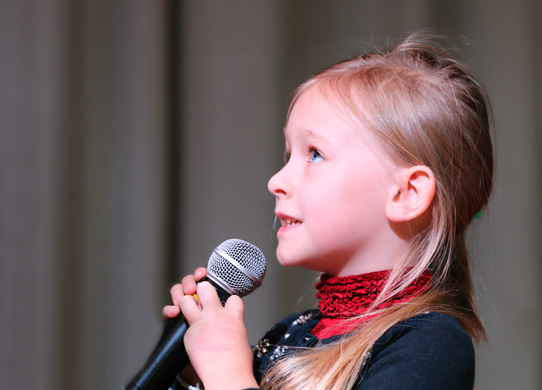
- String instruments
- Pre-school for strings
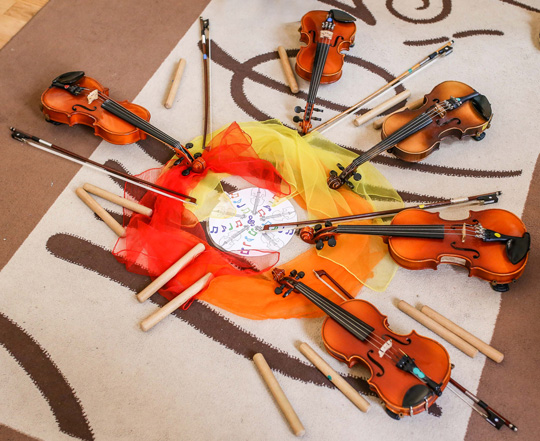
The pre-school for strings provides 5 to 6-year-olds with a hands-on introduction to the violin, viola or violoncello in groups of four or five.
For the duration of a school year, the group meets once a week for 45 minutes to sing, play and make music together. This enables the children to find out whether they like the instrument, and to prepare themselves for potential private or partner lessons later on.
- Little fiddlers
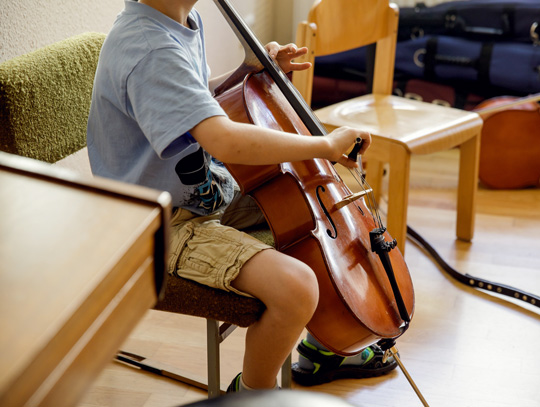
The ‘little fiddlers’ group is based on the concept devised by a well known English music teacher. Six to eight children – beginners in the violin, viola, cello and double bass, aged 5 to 8 – spend 2 years learning the basics of the string instrument together in the group.
Each lesson lasts 45 minutes, with the focus being on encouraging a passion for music-making. New melodies are always sung first – sometimes even in two-part harmony. Songs, active games and rhythmic exercises are accompanied by piano improvisations.
The private or partner lessons are taken alongside the group work.
- Violin
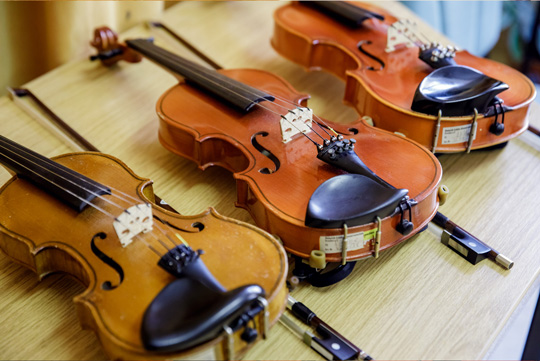
The violin is the best known string instrument. It plays a leading role in symphony orchestras, where it makes up the largest group of instruments. But it is also highly coveted as a solo instrument. To enable even younger children to start learning to play the violin, varying sizes of the instrument are available. Opportunities to play in ensembles are offered right from the start (see ‘little fiddlers’), and the children are able to make music in orchestras and ensembles throughout the entire course.
Recommended age for learning the instrument: from 5 years/teaching individually or in groups
- Viola
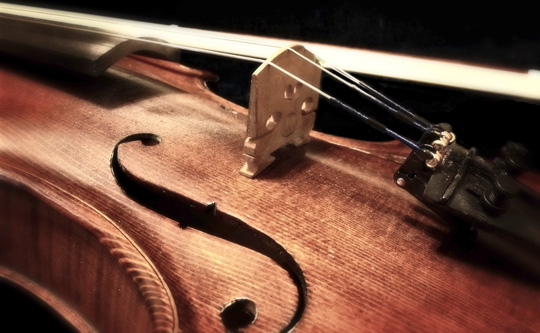
The viola is often referred to as the ‘big sister’ of the violin. Its sound is full, warm and dark. It is a permanent fixture in symphony orchestras, and also plays an important role in chamber music. Even younger children can start playing the viola, as smaller instruments are also available. It is very easy to switch from the violin later on. The course can be supplemented by participation in ensembles right from the outset.
Recommended age for learning the instrument: from 5 years/teaching individually or in groups
- Cello
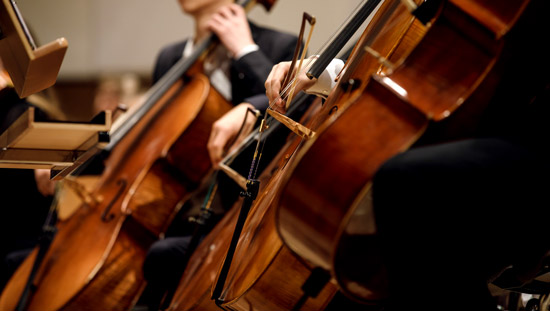
The cello is one of the deeper string instruments. Its shape is similar to a violin, but, when played, it is held upright between the legs of the seated musician. The high ribs make its sound particularly warm and intense. Smaller cellos are available to ensure even younger children can start learning to play them. There are opportunities for the children to play together as an ensemble right from the start (see ‘little fiddlers’).
Recommended age for learning the instrument: from 5 years/teaching individually or in groups
- Double bass
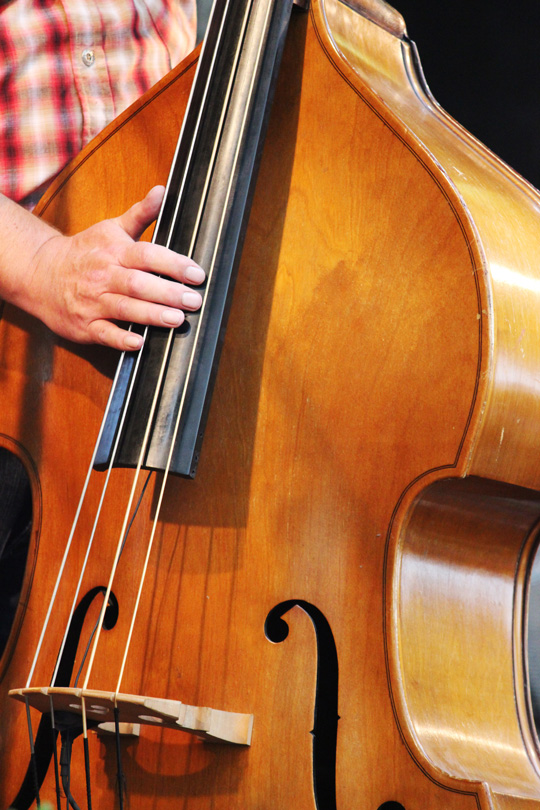
The double bass is the deepest and largest string instrument, laying the foundations for the orchestra. While you can’t exactly hear it specifically, you notice straight away when it’s not there. It can be bowed or plucked, hence its prevalence (sometimes as an e-bass) even in jazz, rock and pop music.
Smaller instruments are available for children to learn on.
Children can also play in an ensemble alongside violins, violas and cellos as part of the ‘little fiddlers’ group.
Recommended age for learning the instrument: from 7 years/teaching individually or in groups
- Viola da gamba (viol)
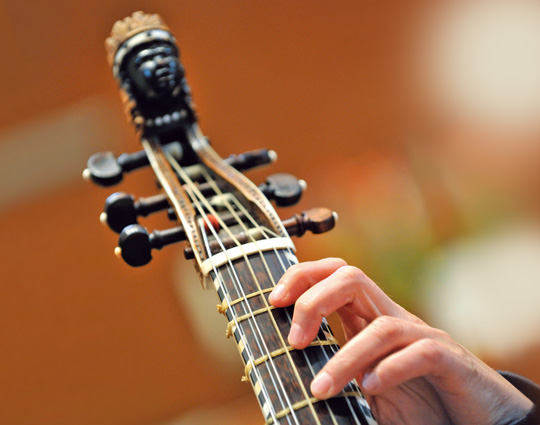
The viola da gamba (viol) is a very old string instrument. Unlike the violin and viola, it is held between the legs like the cello when played, has more strings (generally six or seven), and has frets on the fingerboard. It was played particularly frequently between the 16th and 18th centuries, but is today regaining popularity. There are descant, alto and bass violas de gamba, with the small descant version recommended as an entry point for younger children.
Recommended age for learning the instrument: from 7 years/teaching individually or in groups
- Harp
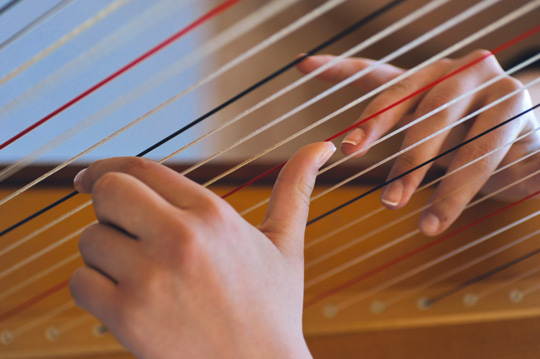
The harp is one of the oldest musical instruments. It belongs to the plucked instrument family, and is plucked with the fingertips.
We teach various types of harps at the Heinrich Schütz Konservatorium Dresden: The hook harp, also known as the Irish harp, whose small size make it particularly suitable for children aged 6 and over; the single-action harp, also known as the folk harp; and of course the large double-action concert harp.
What all these harps have in common is their soft, pleasant sound. It is possible to switch between instrument types at any time.
Recommended age for learning the instrument: from 6 years/teaching individually or in groups
- Brass instruments
- Brass preparatory course
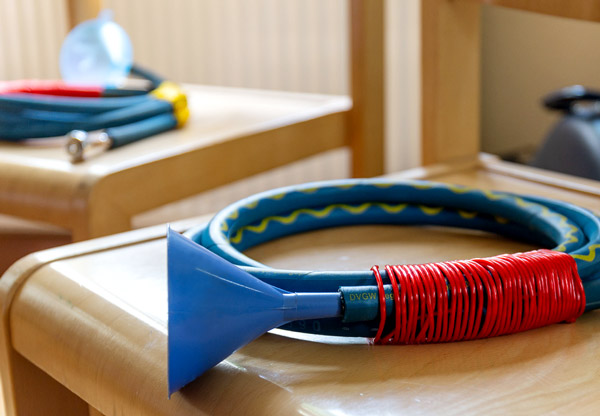
‘No teeth? No problem!’
The HSKD runs a special brass preparatory course for children who are starting school and want to play a brass instrument, but who still have their milk teeth or are in the midst of losing their teeth. The course content includes making one’s own tube instrument, blowing simple signals, hands-on breathing training, singing and training the musical ear, an introduction to notation and organology, rhythmic games etc.
During the second year of the course, lessons can be continued on child-size instruments.The brass preparation course starts in grade 1 and takes place in groups of 4 children (45 minutes). The duration of the brass preparation course can be 1 or 2 years.
- Trumpet
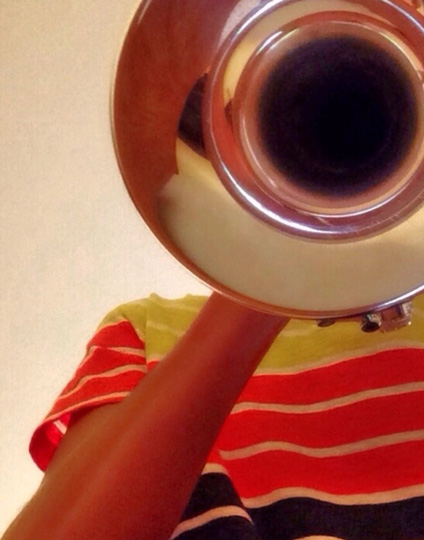
The trumpet is the smallest brass instrument with a cupped mouthpiece. Two types of valve trumpets are currently in use today, and are distinguished by their valve mechanism. Trumpets with rotary valves are known as concert trumpets, while those with piston (or Perinet) valves are primarily played in jazz music.
The German B-flat trumpet (with rotary valve) is the preferred type used in lessons. For younger beginners, we have special child-friendly instruments that are identical to the tuning and playing style of concert trumpets.
Our trumpeters have the opportunity to be part of junior orchestras, and later the brass symphony orchestra or youth symphony orchestra.Recommended age for learning the instrument: from approx. 7 to 8 years/teaching as individual or partner lessons.
- French horn
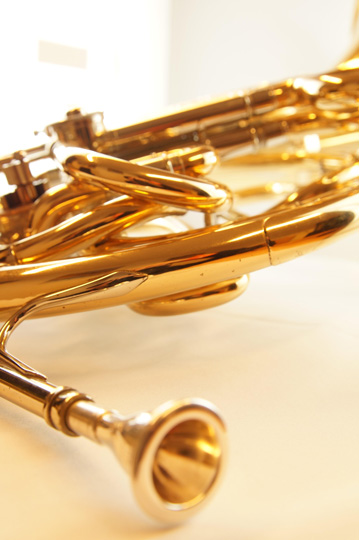
The French horn was referred to as the ‘heavenly instrument’ or the ‘soul of the orchestra’ as early as the 18th/19th century due to its warm, soft sound. It is taught as a B-flat, F or F/B-flat double horn, and is used in classical symphony orchestras and brass symphony orchestras.
Recommended age for learning the instrument: 7 to 8 years, ideal after the brass preparation course or after the change of teeth, later entry possible at any age! Lessons as individual or partner lessons
- Trombone
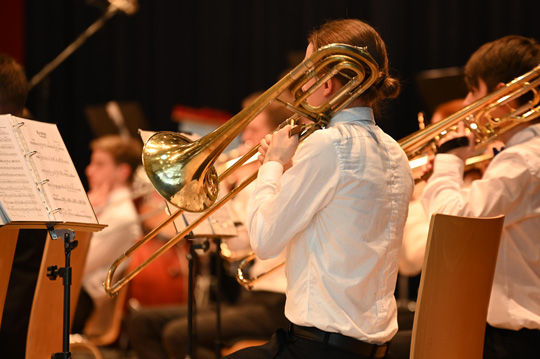
The trombone is a deep brass instrument with a cupped mouthpiece. It is generally built as a slide trombone, e.g. tone pitch is changed via an infinitely movable ‘slide’. The trombone is played in our Dresden youth symphony orchestra, brass symphony orchestra, big band, and trombone quintet ensembles.
Recommended age for learning the instrument: from approx. 9 years/lessons can be given individually or in groups.
- Tenor horn
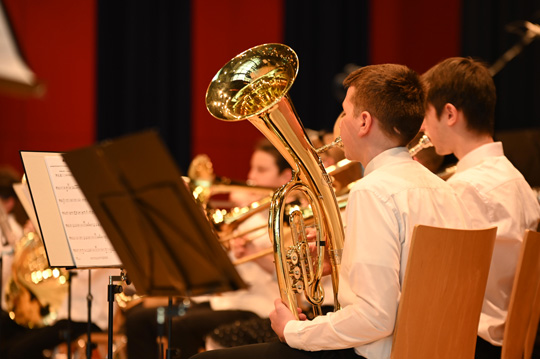
The tenor horn has the same pitch as the trombone. It has a funnel-style mouthpiece and valves similar to a trumpet, and is built in an oval shape. Its diapason (pipe thickness) gives it a soft sound, and it is primarily used in brass music (e.g. the HSKD’s brass symphony orchestra).
Age recommendation for learning the instrument: from approx. 7 to 8 years/lessons possible individually or in groups
- Tuba
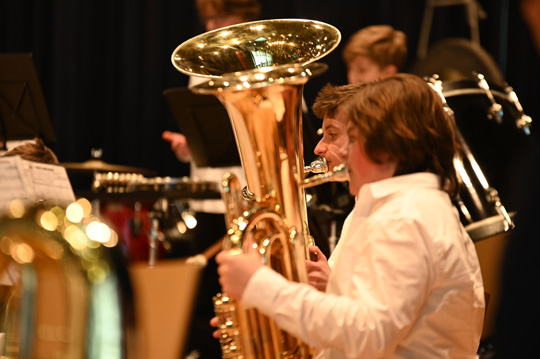
As the deepest brass instrument, the tuba is very important in ensembles. Its design is similar to that of the tenor horn, only larger. The tuba has 3 to 6 valves, depending on the model. The two most common forms we use are the F and B-flat tubas. This instrument can be found in brass or symphony orchestras, and in brass chamber music.
Age recommendation for learning the instrument: from 12 years/lessons in individual or partner lessons
- Woodwind instruments
- Orientation course for woodwinds
This course is aimed at students who have not yet been able to, or do not yet want to, commit to a specific woodwind instrument. It serves to familiarise them with the various instruments in this family. The students take partner lessons in each instrument (bassoon, oboe, clarinet and flute) in consecutive 3-week blocks. This enables them to gain initial instrument-specific impressions, and perform small exercises. At the end of the course, they will be given the chance to take up the desired instrument if interested.
To the registration form (PDF, german)
For your registration please print the PDF document and send the completed form to the student office.
ab ca. 10 Jahren/Unterricht im Partnerunterricht
- Clarinet
The clarinet is a woodwind instrument. The sound is produced by a simple piece of natural reed affixed to the mouthpiece. The clarinet is a permanent fixture in the symphony orchestra and brass symphony orchestra, and also plays an important role in brass chamber music and as a solo instrument. It is also an essential part of brass orchestras, jazz, klezmer music and folk music.
ab ca. 8 Jahren/Unterricht einzeln und in Gruppen möglich
- Oboe
The oboe is a woodwind instrument whose mouthpiece, which generates the sound, consists of a double reed. Its sound varies from nasally clarion to dark and velvety – it is likely the closest to the human voice in terms of its expressiveness. The oboe is a permanent fixture in youth symphony and brass symphony orchestras, chamber music, and as a solo instrument.
ab ca.10 Jahren (vorher als Einstieg Blockflöte empfohlen, ist aber nicht Bedingung)/Unterricht vorwiegend einzeln
- Bassoon
The bassoon is a deep woodwind instrument whose sound is generated by a double reed made from a special type of reed material. The bassoon can reach very low, but also very high pitches. It is used in orchestras and as a solo instrument. In chamber music, it plays a particularly important role as a bass.
ab ca. 6 bis 7 Jahren mit Fagottino/ab ca. 10 Jahren mit Fagott (vorher als Einstieg Blockflöte empfohlen, ist aber nicht Bedingung)/Unterricht vorwiegend einzeln
- Saxophone
The saxophone is a woodwind instrument, even though it is made of metal. Much like a clarinet, its sound is generated using a single reed affixed to the mouthpiece. The saxophone family consists of several instruments with varying pitches, the best known being the soprano, alto, tenor and baritone saxophone. Saxophones are very versatile. Originally used in military and, especially, jazz music, they now also feature in symphonic music, chamber music and, in particular, dance music.
ab ca. 9 Jahren/Unterricht einzeln und in Gruppen möglich
- Flute
The flute is a woodwind instrument. Although its main body is today generally made of metal, it was originally wood. The flute comes in varying sizes and pitches – from the high piccolo to the deep sub-contrabass recorder. The flute is used in orchestras – including as a solo instrument – and in chamber music.
ab 5 Jahren mit Piccoloflöte/ab ca. 7 Jahren mit Kinderquerflöte/ab ca.10 Jahren mit Querflöte/Unterricht einzeln und in Gruppen möglich
- Recorder
The recorder is a woodwind instrument. It comes in various sizes – the smallest having the highest pitches, and the largest having the lowest. The instrument existed as early as the Middle Ages, becoming most prevalent during the baroque period. Various recorder ensembles enable joint music-making at the HSKD.
ab 5 Jahren/Unterricht einzeln und in Gruppen möglich
- Plucked instruments
- Guitar and mandolin
We currently have twenty staff teaching plucked instruments. This ensures a wide range of teaching methods, specialisations and styles, and gives the students well-founded training in the classical guitar, mandolin and acoustic guitar. The lessons are tailored specially to the students’ specific needs, with the main focus being on a passion for music.
One of our key missions is to enable our students to make music together, and our junior orchestra gives children the opportunity to directly apply their newly acquired skills and knowledge. The plucked-instrument orchestra (Bundinstrumentenorchester B.I.O.) is open to anyone who has completed the lower-level training, while the acoustic ensemble provides an introduction to the acoustic scene. The adults’ ensemble also welcomes new enthusiasts.Age recommendation for learning the instrument:
Guitar from age 7, Mandolin: from age 7.
Lessons as individual, partner and group lessons
- Keyboard instruments
- Piano
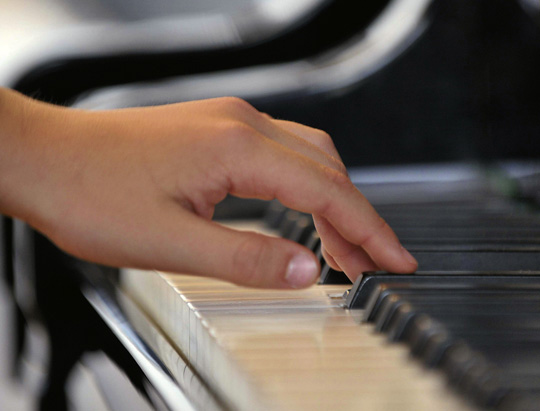
Piano can start being taught right from pre-school age (six years old). As an entry point, we recommend attending out ‘Music workshop for piano’ (exclusively for children of pre-school age).
We offer lessons for individuals, partners and talented pupils, and encourage ensemble-playing through various chamber-music groups.
- Accordion
- Accordion
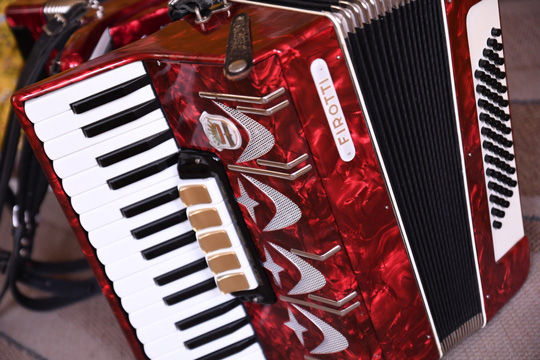
The accordion is a hand-stop/harmonica instrument which generates its sound through metal tongues that start vibrating as a result of airflow. The popular instrument is very versatile, appearing in folklore, pop, jazz, and even in classical concert music.
Children as young as five can learn this instrument at the HSKD. There is no age restriction. Lessons at the HSKD are taken in tandem with training in the instrument itself, the general foundations of music, targeted assistance in co-ordinating both hands, and preparing solo pieces in the desired music genre. Lessons can be taken on a private, partner or group basis.Recommended age for learning the instrument: from 5 to 6 years old
- Singing
- Singing classes
As the most original instrument, the singing voice offers excellent opportunities for development and musicality, particularly during the first few years of schooling. The singing classes enable child-friendly, healthy hands-on training in the basics of tones and sound. These lessons are offered in groups of approx. 5-8 children. They may also serve as a logical continuation of the early musical education, orientation courses, or as bridgers to starting instrument lessons.
- Child voice training
The child voice training option is the ideal lead-in to singing classes, and is of course also open to other interested parties. With its exercises in breathing techniques, head-based resonance and articulation, it is based on the recommended principles for developing children’s voices. Here, once again, the idea of cultivating musicality is a key focus. Lessons are offered in groups of approx. 3-5 children.
ab dem 10. – 12. Lebensjahr, eine Unterrichtsstunde umfasst 45 Minuten
- Classic singing lessons
This lesson format is suitable for interested parties as a continuation of the child voice training, and for beginners, and is available on a private and partner basis. The staff offer customised training programmes, and are able to assist with all kinds of development methods. In addition to joyful music-making and singing, this includes accompanying sing-along exercises in various choirs, or, in the case of particularly talented pupils, preparation for studies in singing or music education.
ab dem 12. Lebensjahr, Partner- und Einzelunterricht
- Classes for adults
These lessons encompass all the positive aspects of voice training. We can cater specifically to the needs of voice-intensive professions, such as teachers. Lessons may also be available for entire families, depending on teaching capacities.
Gruppen-, Partner- und Einzelunterricht
- JEKISS
JEKISS ("Jedem Kind seine Stimme") is an offer for the musical education of children in primary schools - regardless of cultural or financial background. The aim is to familiarise your child with the different singing possibilities of his or her voice through playful exercises. Knowledge of music is not required!
Children who sing regularly develop a feeling for sound and rhythm. They learn to shape sounds in different ways and to present themselves on stage. JEKISS focuses on singing together. It supports the development of your child's cultural identity and promotes intercultural dialogue.
JEKISS takes place once a week in our Dresden cooperation primary schools - as an offer for the 1st to 4th classes. A JEKISS lesson lasts 60 minutes; participation is voluntary and free of charge. The choir director is a music teacher from the HSKD. The children learn different songs, partly with movements or dance steps. The JEKISS children can show their skills at a performance, e.g. at the school's Christmas caroling or summer festival.
The primary school teachers integrate some of the JEKISS songs into the school day, so that all the children in the class and later the whole school can sing these songs together. Registration for JEKISS is done through the class teacher at the respective cooperating primary school.
You can find more information about JEKISS in our flyer (in german).

- Jazz/Rock/Pop
- Singing
These classes revolve around voice training, a process in which students learn the technicalities of singing. Songs from all genres of popular music, e.g. pop, jazz, musicals, rock and chanson, are of course covered. Interpretation skills are also trained.
ab ca. 14 Jahre
- Trumpet
The trumped is a high-pitched brass instrument with a cupped mouthpiece and valves to change pitch. It can be built with varying tunings. At the Heinrich-Schütz-Konservatorium, the trumpet is used in ensembles such as the Big and Small Bands.
ab ca. 9 Jahre
- Trombone
The trombone is a low-pitched brass instrument with a cupped mouthpiece. It is generally built as a slide trombone, i.e. an infinitely movable slide is used to change pitches. It is one of the ‘permanent fixtures’ in our Big Band.
ab ca. 9 Jahre
- Saxophone
The saxophone is a woodwind instrument with a key mechanism. It consists of a broad, conical brass tube to which a single reed is affixed, similar to a clarinet. There are different sizes, the most common being the soprano, alto, tenor and baritone saxophone. The instrument is used in our saxophone ensembles and the HSKD’s Big Band.
ab ca. 9 Jahre
- Keyboard
Synthesisers, samplers, sequencers and so-called ‘music workstations’ have now become an essential part of radio, television, film & advertising productions, bands, and even some living rooms. The keyboard combines most of the functions of the aforementioned machines. As part of keyboard lessons, for example, you will learn how to use the keyboard’s different sounds, how to programme a sequencer or sound, and also how to read music.
The lessons are usually held in small groups, which often act as small bands. For example, one keyboarder can play the bass, and the other the drums, while others play the melody or chords together.ab ca. 6 Jahre
- Piano
Most of you have no doubt seen a piano or digital piano. At the Heinrich-Schütz-Konservatorium, you can also learn how to play the piano in the genre of ‘popular music.’ Similar to ‘classic’ piano lessons, you will learn the technical bases (e.g. good dexterity), and be able to practise some classical piano pieces too. You will also train in playing based on chords, by ear, and by improvising in various styles. The different bands and ensembles additionally give you the opportunity to play together with other musicians.
ab ca. 6 Jahre
- Guitar
The guitar is a stringed instrument (see classical guitar), and we offer courses in both acoustic and electric guitar (e-guitar). The guitar is used in almost all styles of popular music.
ab ca. 9 Jahre
- Bass
The bass is one of the most important parts of an ensemble, and usually has 4 strings. As a double bass, it is primarily found in symphonic music, but also jazz and swing. The e-bass (electric bass guitar) is at home in all styles of popular music (jazz, rock, pop, Latin etc.).
ab ca. 14 Jahre
- Drums
- Drums
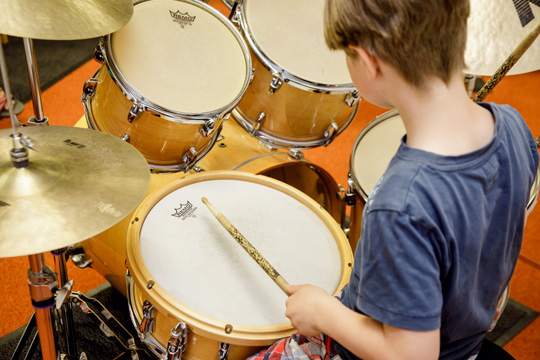
The drummer is the ‘rhythm-maker’ in the truest sense – whether in a band or symphony orchestra.
Our percussion department thus combines all drumming instruments under one roof. If you enjoy drum sets in rock, pop or jazz, or dream of playing the timpani in an orchestra, or are interested in Latin American drums, or perhaps all of the above, you’re bound to find the right option for you in our range of courses!
- Dance
The dance education at HSKD has a long tradition. For over 65 years we have not only been training instrumentalists, but also have our own dance department with currently more than 700 dancers! The training covers the areas of children's dance, modern dance, classical dance, jazz dance and folklore. In the "boys only" courses offered especially for the boys and gentlemen of creation, the young students learn that dancing can be a man's thing - wild, powerful, playful ... but also gentle and quiet at times.
Supervised by qualified dance teachers and experienced répétiteurs, the young dancers learn to use their own urge to move and to direct it in a targeted manner using various techniques. They constantly work on posture, flexibility and strength, and creativity and creative will are encouraged.
From the 1st dance class onwards, our students have various performance opportunities: our annual end-of-school presentation in professional theatres, our own dance productions, student concerts or participation in opera productions in cooperation with the Semperoper Dresden.
Timetable for the school year 2023/24
You can download our timetable here (PDF, in german, Status: 30 November 2023).
Free places in dance classes and courses are marked in green. We are looking forward to your registration!- Early dance education (EDE)
Early dance education is aimed at children aged 3 and over, and is geared around the concept of creative children’s dancing. This picks up on, and fosters, children’s enthusiasm for playing and movement. Basic dance steps are taught, and co-ordination, stretching and strength exercises incorporated into the class. The piano accompaniment further encourages and supports the children’s musical training.
For a direct consultation, please contact Darina Umanskaja on umanskaja.darina@hskd.de.Unterrichtsorte: An der Loge, Bautzner Str. 19 Kraftwerk Mitte, Lichtwerk 22 TENZA, Pfotenhauer Str. 59
- Boys only
The ‘Boys only’ course is a dance class exclusively for boys aged 4 and over. Our experience has shown that boys require a different approach to dance than girls. The themes and methods are tailored directly to the students’ mental and physical needs. Basic dance steps are taught, and co-ordination, stretching and strength exercises incorporated into the class. The piano accompaniment further encourages and supports the children’s musical training.
For a direct consultation, please contact Darina Umanskaja on umanskaja.darina@hskd.de.
Unterrichtsorte: An der Loge, Bautzner Str. 19 Kraftwerk Mitte, Lichtwerk 22 TENZA, Pfotenhauer Str. 59
- Dance classes
The dance classes tie in with our pre-school programme, and are aimed at children aged 6 and over. They teach creative children’s dancing, which cultivates the students’ passion for playing and movement. The idea is to encourage and broaden imagination and sensitivity in order to discover and expand individual scope for movement. Another focus is on teaching movement processes and choreography. The dance technique taught is modern dance. After year 2, the classes split into two
streams: Dance classes held once a week, and conservatory support classes that provide training twice a week. Regular stage performances are also part of our course.
What is modern dance?
The focus is on training the spatial and co-ordination-based awareness, and developing a specific momentum of movement. Improvisation plays a key role here. The pupils are allowed to be creative and explore the many different possibilities themselves.For a direct consultation, please contact Darina Umanskaja on umanskaja.darina@hskd.de.
Unterrichtsorte: An der Loge, Bautzner Str. 19 Kraftwerk Mitte, Lichtwerk 22 TENZA, Pfotenhauer Str. 59
- Conservatory classes
There are various types of dance courses available at the HSKD: Up to year 2, all our pupils take lessons in creative children’s dancing once a week. After year 2, the course is split into two streams: Dance classes held once a week, and conservatory support classes that provide training twice a week. For the latter, we offer classical dance and jazz dance, in addition to modern dance, as supporting minor subjects from year 6 onwards. Apart from teaching solid dance techniques, the focus of the classes is on choreography. We not only give our special-needs students the opportunity to regularly perform on stage, we also enable them to be part of feature-length, interdisciplinary dance productions.
Unterrichtsorte: An der Loge, Bautzner Str. 19 Kraftwerk Mitte, Lichtwerk 22 TENZA, Pfotenhauer Str. 59
- Company
The company includes a number of dancers who have gone through our training programmes. They train (modern/contemporary dance) and prepare choreographies once a week. The level is very high, and is only designed for dancers with prior knowledge.
What is modern dance?
The focus is on training the spatial and co-ordination-based awareness, and developing a specific momentum of movement. Improvisation plays a key role here. The pupils are allowed to be creative and explore the many different possibilities themselves.For a direct consultation, please contact Darina Umanskaja on umanskaja.darina@hskd.de.
Unterrichtsort: An der Loge, Bautzner Str. 19
- Dance movement training (DMT)
The dance movement training is open to mature adults who do not necessarily have to have any prior dance knowledge. It unlocks the door to better understanding one’s own body, and is geared around functional physical education. The focus is on enjoying movement and experimentation, musicality, and cultivating a sense of space and one’s own body.
For a direct consultation, please contact Darina Umanskaja on umanskaja.darina@hskd.de.
Unterrichtsort: Palucca Schule Dresden, Basteiplatz 4
- Music theory
- Composition
Composition classes are not run as courses, but rather as private lessons. They are aimed at school students interested in inventing and writing their own music. Music theory courses U I, U II and M I are highly recommended to provide a foundation.
In addition to listening to and analysing music pieces, the focus is on cultivating one’s own creativity. Work on one’s own compositions is accompanied by practical familiarisation with all conventional instruments, meetings with composers, and attending contemporary music performances.
A concert featuring the new compositions is held annually.- Improvisation
This course is particularly aimed at students of popular music who enjoy playing their instrument creatively with others.
- Music theory
Why do I need music theory? I’m learning enough with my instrument!
There are some surprising answers to this justified question. Here are just a few:
• Good knowledge of music theory makes it much easier for you to work on a music piece by cultivating your sight-reading abilities!
• You’ll reach a more expressive level of playing sooner, as knowledge of music theory enables you to understand the flow of a music piece faster and to greater depth!
• Many pupils repeatedly affirm that it is much more fun when you know ‘what’ you are playing. Looking over the composer’s shoulder is interesting and often full of surprises!
• If you fancy the odd bit of improvisation or just enjoy playing extensively, or if you sometimes hear a melody you’d like to write down or play yourself, music theory will help you a lot!
Music theory is an important companion to instrument and singing lessons; it makes it easier to work on a piece of music, enables you to identify and understand correlations important for good interpretation, trains your ear, helps with sight-reading, and provides interesting insights into the manuscripts and handwriting of composers from all different eras.
The HSKD offers examinations for VdM-compliant qualifications at a lower level, intermediate level, and upper level.
• Documents for the UII crash course in music theory (german)
• Documents for the MI crash course in music theory (german)
•Documents for the MII crash course in music theory (german)SCHOOL YEAR 2023/24
Here you can find an overview of the weekly courses.
Aural training:
6 January 2024 | 13 January 2024 | 3 February 2024
10am – 12pm in Room B 1.1
Crash courses:
U II: 17 November 2023 + 18 November 2023 (Application deadline: 3 November 2023)
M I: 9 February 2024 + 10 February 2024 (Application deadline: 26 January 2024)
M II: 7 June 2024 + 8 June 2024 (Application deadline: 24 May 2024)every Friday from 15.30 to 17.30 and every Saturday from 10 to 14.30 in room B 1.1 (Glacisstraße 30/32, 01099 Dresden)